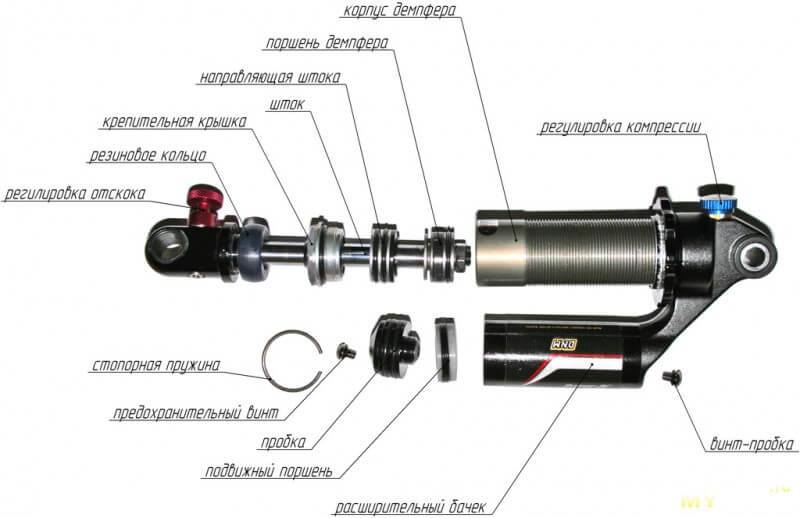The time of the first bicycles, which were called “shaky bones,” is long gone. Modern two-wheelers are equipped with a device designed to absorb shocks, prevent the structure from rocking when riding in specific conditions. The bicycle shock absorber is called the heart of the suspension. The comfort of the cyclist, the speed of movement, the service life of the bike depend on the correct choice and adjustment of the important node.
What you need a rear shock absorber for a bicycle
The selection of a two-wheeler depends on the purpose of riding. For riding in the city, the preference is given to the hardtail. For rides in places riddled with ditches and holes, forest and mountain trails, it is better to use a bicycle with a rear shock absorber. The suspension makes the trip comfortable, smoothing out the bumps in the road. When going downhill, the device protects the rims from shocks.
It feels as if the rear wheel is stuck to the ground. Some bikes have a built-in locking device. The design element helps the bike ride on a paved road like a hardtail, but with a distinctive feature. When encountering bumps or potholes, the force of the shock removes the lockup and activates the suspension.
A rear bicycle shock absorber performs the following functions:
- alleviates the discomfort of cyclists when overcoming obstacles on the track;
- reduces the load on the frame;
- protects the cyclist from shocks at high speeds;
- eliminates the force of the front wheel;
- dampens sway, stabilizes motion of the bicycle;
- provides stability on the road.
The disadvantage is considered to be the difficulty when riding Uphill—how-to-learn–tips and the high weight (compared to the hardtail).
Varieties and their differences
The analogue of the car design is assembled from two sliding tubes, a damper with lugs that fasten the device to the frame. Smooth operation is ensured by a special type of bearings – bushings. The rear shock absorber consists of a spring and a damper. Suspension with a locking ring damps the sway of the bicycle and fixes the degree of subsidence. Damper stabilizes the smoothness of motion. The design is made to suit the type of frame and is divided into two types, each with its own nuances.
| DIFFERENCES AND FEATURES | |
|---|---|
| Spring | Air |
| The cushion is located on the outside of the product | Significantly lighter than a metal product |
| Made of steel alloy or high strength titanium | Has an air cartridge inside |
| They are very stiff, with no cushioning | The air pumped into the fork damps vibrations as you ride |
| Keeps your bike stable on rougher trails | Pump-operated, with a pump that closes the passage of gas or fluid (valve) |
| Eliminate violent shocks, even at maximum speed on difficult terrain | Have more adjustments |
| Fitted on cheap models as well as sports bikes | More expensive than spring devices with less reliability on rough roads |
Rear shock absorbers are also available in combined types:
- The spring-elastomer type consists of a stiff steel spring and a rubber damper. The bicycle shock absorber is designed for riding on a rutted track with small obstacles. The disadvantage is considered susceptible to cold, which reduces the ability to dampen vibrations.
- Air and oil: the function of the spring is performed by air pumped into a sealed chamber, the damper replaces the cartridge with oil.
- Combined shock absorbers. The design includes an oil damper, mechanical and air springs.
A set of adjustments helps adjust spring stiffness, change the size of the oil valves, and control air pressure.
Ways to adjust a bicycle’s rear shock
Adjustment of the system is necessary for a comfortable ride, full operation of the running parts of the bike, reducing the risk of structural damage.
Step-by-step adjustment is carried out in three ways:
- Checking the flexibility of the spring.
The indicator indicates the level of resistance of the shock absorber to external loads and body weight. The cyclist selects the optimum condition. When adjusting pay attention to the following: the stiffest spring does not counteract shocks when riding bicycles. A weakened part reduces the smoothness of the ride, can break the shock absorber when riding on difficult trails with obstacles. Consequently, it is necessary to buy a device with a higher level of load. The more force is needed to compress the spring, the stiffer the kickback will be when riding.
- Adjust the rate of compression and return of the part in place.
This method adjusts the rear shock absorber of the bicycle to the conditions of riding (off-road, driving on a forest or mountain trails). The length of the fork stroke is adjusted by reducing or increasing the distance reserve. This reduces wear and tear on the springs. On spring units, the amount of slack is changed with a retaining ring. The ideal setting is 25%. The air structures are adjusted by adjusting the oil valve. To control the level of subsidence, the manufacturers have installed a colored rubber band that shows the appropriate variation.
- Stroke Lockout.
A softening adjustment is needed for riding the bike on level roads where there are no unexpected shocks (such as a paved trail). The spring is given a stiffness that prevents deformation. Locking is used to temporarily stop the fork when riding with long climbs.
Repairing the Rear Shock Absorber
The complex process of disassembling the shock absorber of a bicycle requires attention. If there is no assurance that the cyclist will not mix up parts when reassembling, it is better to go to a workshop. Repair begins with the removal of the fork, for which the bike is lifted up with the wheels. What to do next, will prompt a step by step instruction.
Remove parts of the device in the following sequence:
- part for regulating the speed of movement – rim brakes;
- the wheel, which receives the greatest loads;
- steering bracket (horizontal tube with a vertical fork stem);
- support ring and fork;
- metal or air spring (unscrew force adjustment bolts before removal);
- remove the oil dampener from the fork;
- remove the seals (a screwdriver will help);
- take out shock absorber;
- inspect, clean, lubricate parts;
- Replace worn or broken elements;
- install the components in reverse order on the bike.
After repair, the rear shock works almost perfectly.
Selection Tips
Inconsistency of the rear shock absorber to the type of frame changes the geometry of the suspension and worsens the comfort of the cyclist during the ride. When buying the “heart” of the suspension, you can not go wrong in the choice, the warranty, the best price. Professionals advise:
- Buy a shock absorber that is recommended by the manufacturer of the bike.
- The device is selected depending on the purpose of riding, the model of the bike, the amount of budget.
- The design should fit the frame of the bike. Each product has an axle length and stroke of the rod.
- When buying a cross country air device, look for a colored rubber band on the outer drain to help with design adjustments.
- The standard spring is designed for the average cyclist. Therefore, the product is chosen based on their weight and personal preferences.
- Combined shock absorbers with oil reservoirs are designed for the advanced level of rider.
- To work properly, the fork and shock absorber must be balanced with each other. All seams and joints are checked for neatness of execution.
- When selecting a shock absorber with a built-in lockout, make sure there is a special valve in the rear triangle.
- The catalog number of the rear unit should match the numbers on the box.
Conclusion
Poor operation of the rear shock absorber – not a reason to panic. The device can be repaired with your own hands or replaced with a new one. Timely response to the malfunction will extend the life of the two-wheeled vehicle and ensure a comfortable ride for the cyclist.









